The Vishera Review: AMD FX-8350, FX-8320, FX-6300 and FX-4300 Tested
by Anand Lal Shimpi on October 23, 2012 12:00 AM ESTProjected Performance: Can AMD Catch up with Intel?
I keep going back to this slide because it's incredibly relevant. It's the only indication we have from AMD of what its future roadmap will look like in terms of performance increases:
Each year AMD promised to increase performance of its high-end cores by roughly 10 - 15%. Astute observers will note that, at this rate, AMD will almost never catch up to Intel. AMD at the time was careful to point out that it's talking about 10 - 15% gains in core performance, and it could potentially see even larger increases in total chip performance by pulling other levers. Vishera is an example of AMD doing just that. The Piledriver cores by themselves don't increase performance tremendously, but they do give AMD a little more thermal headroom to work with thanks to some more efficient design decisions and better transistor choice. With Vishera, AMD took the additional power headroom and turned into a frequency advantage. The result is AMD's FX-8350 can operate in the same power envelope as the outgoing FX-8150, yet runs at an 11% higher base clock (turbo frequency remains the same). Through frequency and core level improvements, AMD was able to deliver a bit more than the 10 - 15% performance increased in promised.
If AMD is able to repeat these improvements again next year, I wondered whether or not it would get any closer to closing the gap with Intel - particularly when it came to single threaded performance. We already know from our Haswell investigations that Intel is expecting around a 5 - 15% increase in CPU performance from Haswell over Ivy Bridge. If we assume that Haswell delivers towards the 15% end of that spectrum, and if we assume that Steamroller delivers the same level of improvements that we saw from Piledriver/Vishera, we end up with some pretty interesting predictions for where things end up next year. I modeled the 2013 performance of high-end AMD and Intel platforms based on those two factors and plotted the curves in a few different benchmarks. For each generation I used the parts that AMD stacked up against one another (they are also fairly similarly priced). For 2011 I used the FX-8150 vs. Intel's Core i5 2500 and for 2012 I used the FX-8350 vs. Intel's Core i5 3570. The 2013 data is of course projected based on a 15% increase in performance from Haswell, and a repeat of the Vishera vs. Zambezi increase for AMD. This is mostly an interesting experiment so don't get too invested in the data.
We'll start with Cinebench, by far the most painful of the tests for AMD from a single-threaded performance perspective:
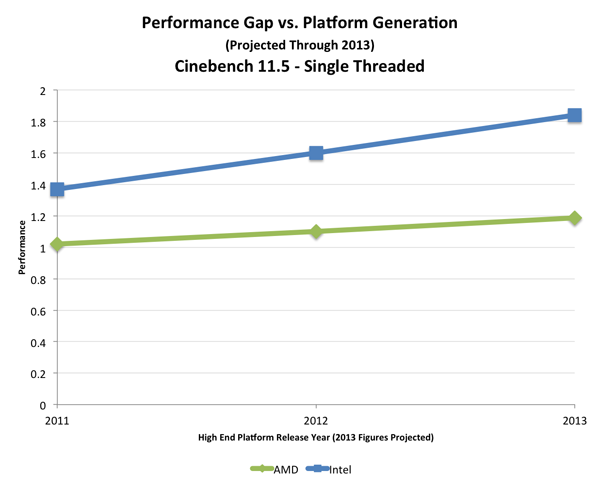
The Vishera gains here were decent but not enough to dramatically shrink the performance gap. Furthermore, Intel put a good amount of distance in place with Ivy Bridge and if it can continue that with Haswell I don't see much hope here.
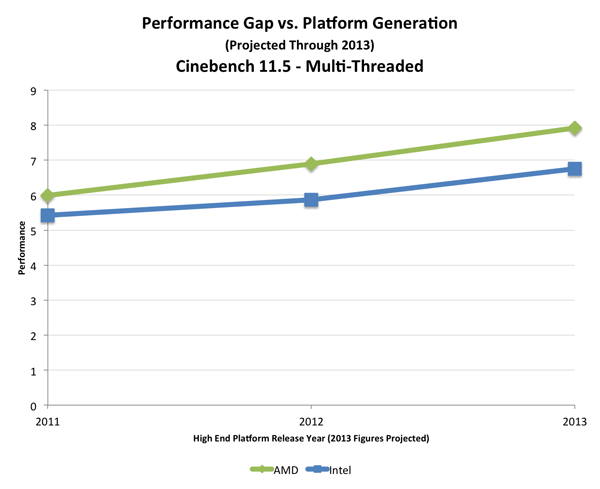
The multithreaded Cinebench results begin in AMD's favor and remain so even with our projected performance data.
Mozilla's Kraken benchmark is another example of single threaded performance gone awry for AMD.
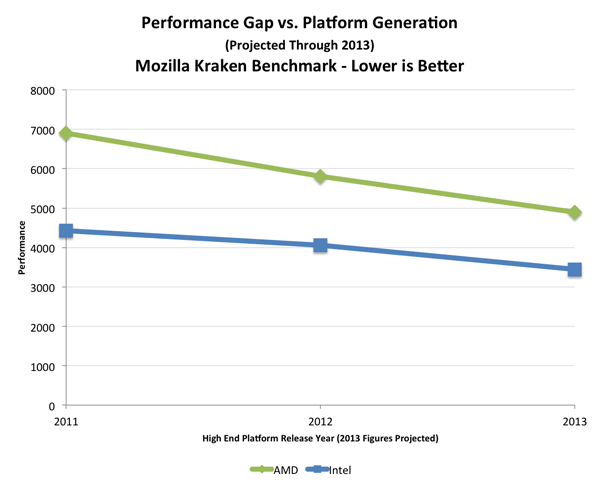
Thankfully, Vishera does close the gap by a decent amount and if AMD extends those gains it is on an intercept course with Intel. The bad news is, that intercept wouldn't be in 2013.
POV-Ray provides another point of view on single threaded performance, here the situation looks far less dire than under Cinebench:
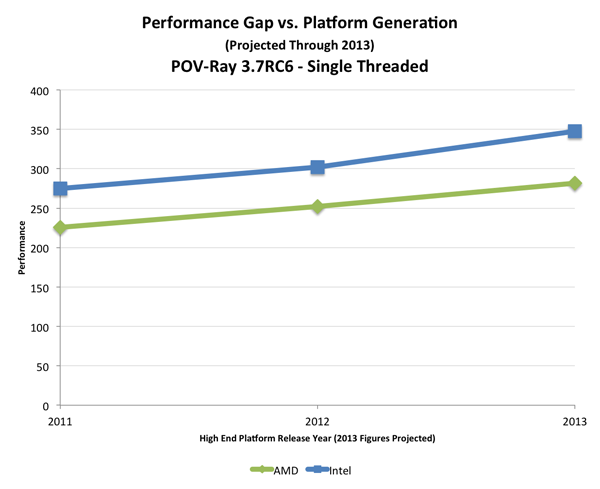
Unfortunately the curves remain fairly distinct.
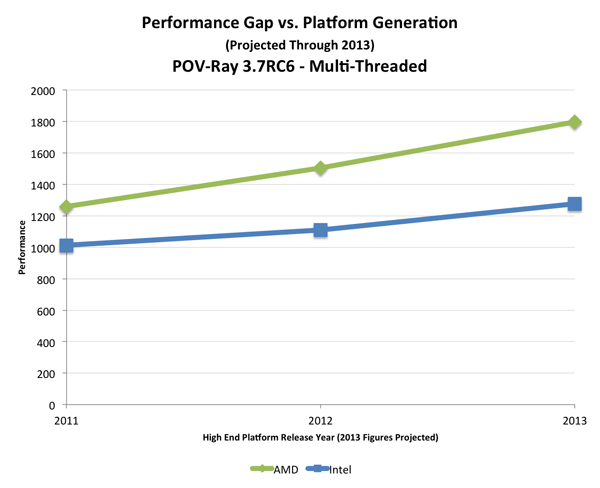
Once again, when we increase thread count we see AMD pull ahead.
SYSMark is a particularly telling benchmark as it is lightly threaded and does a good job of simulating all types of workloads:
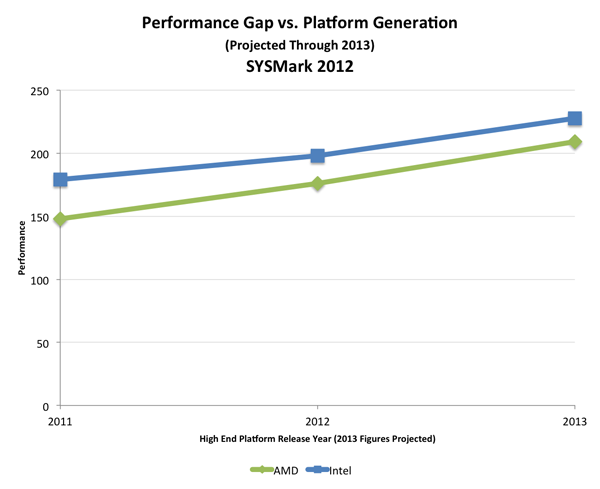
The result here is AMD closing in, albeit slowly, on Intel's performance advantage. I suspect this is quite possibly the best case scenario for AMD, it doesn't necessarily want to surpass Intel in performance but it wants to get close enough where pricing and other factors (e.g. GPU performance in its APU parts) can make a bigger difference.
Our Visual Studio 2012 test is a good combination of single threaded and multithreaded workloads in one:
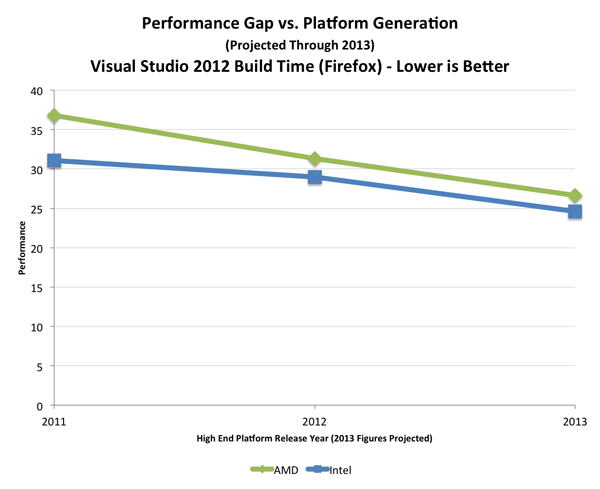
With Vishera, AMD did a lot to close the gap betwen itself and Intel. Another increase like this and we won't see AMD surpass Intel, but the two should remain fairly close.
These last two tests show us the other side of the coin. If both AMD and Intel continue on their present tracks, what will happen in a test where AMD already does well today?
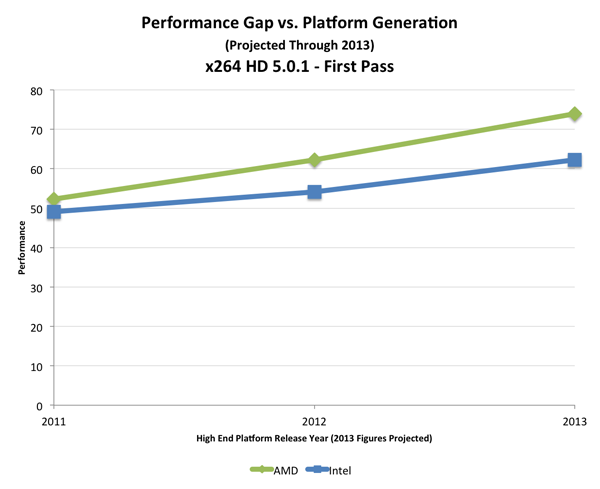
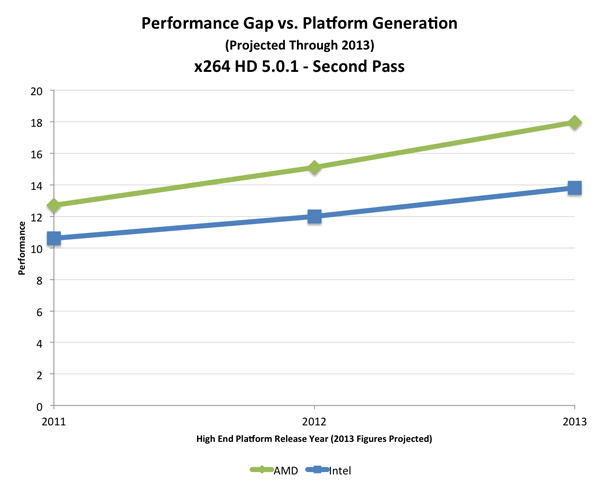
In areas where AMD holds a significant advantage, Haswell would need to deliver more than a 15% gain in performance at the same price point to catch up.
None of the results here are all that surprising. AMD remaining on its current course isn't enough to dramatically change its standings vs. Intel in another year. Vishera definitely cut into the performance delta, but the 2013 follow-up will have to do even more to really have an impact. Steamroller is far more focused on increasing IPC, however without a new process node it'll be difficult to demonstrate another gain in frequency like we see today with Vishera. I suspect the real chance for AMD to approach parity in many of these workloads will be with its 20nm architecture, perhaps based on Excavator in 2014.











250 Comments
View All Comments
c0d1f1ed - Tuesday, October 23, 2012 - link
The Projected Performance page doesn't appear to take AVX2 and TSX into account, not to mention improved Hyper-Threading performance by having an extra execution port. The 10-15% number is for single-threaded workloads only. Everything else will see a much bigger leap.AMD is screwed unless it adds AVX2 and TSX support sooner rather than later. They haven't made a single mention of it yet...
tekphnx - Tuesday, October 23, 2012 - link
From a price-performance perspective, I think that FX-6300 is the most interesting part here. For barely more than the i3-3220, you get essentially the same performance in games and 20-30% better performance in multithreaded applications. And, as time goes on and games become more multithreaded, the FX-6300 will pull ahead in games, too. At 95w, the power consumption is much higher than Intel, but it's manageable. Plus, it's overclockable, unlike the i3.Spunjji - Tuesday, October 23, 2012 - link
Add in the potential for ~10% savings under load with a bit of undervolting and it looks even better. One to watch for those who, like me, would rather buy AMD if it doesn't smell like shooting yourself in the foot.CeriseCogburn - Tuesday, October 30, 2012 - link
Got any toes left ?lol
Didn't think so.
rocky12345 - Tuesday, October 23, 2012 - link
HelloI am a long time reader of this site pretty much since it first started. Heck in the time this site has been running I have gone through probably 35 or more computers & currently have 11 in my home that are used for different tasks. I also went through a wife but thats another story to tell lol.
Anyways what I was wondering is this. In the past with AMD I noticed a huge gain in CPU out put when raising the bus speed up to as far as the hardware would go. What I am wondering is what if you took a 8350 raised the bus up as high as it would go but keep the multi set that the CPU would run at default speed & do some test in both single threaded & multi threaded programs as well as a few games where this CPU is a bit lacking to see if the CPU itself is being held back by the bus. Then try to do both the bus at high & raise the Multi to the max CPU speed of 4.8Ghz & see what raising both the bus & CPU speed do.
I am hoping it has the same effect as it did in the older AMD CPU's & gives a nice boost. I think maybe the bulldozer & piledriver core might be held back by a lack of bandwidth to the rest of the system resources. If not then at least it was a fun little side project for you guys. maybe raise the memory speed as well to make sure that is not the issue too. Just an idea that may open up some hidden performance in the CPU hopefully. I would do it myself but at the moment the only AMD system I have left if a older Athlon 64 x2 6400+ that the step son uses to surf the web & play a few games on.
thanks
lmcd - Tuesday, October 23, 2012 - link
If I remember right with AM3+ there isn't really a bus to raise.CeriseCogburn - Tuesday, October 30, 2012 - link
Oh yeah, how come we don't have the big speculation all the time solidified into the standard commentary and "looking for the validation on the tests" concerning what's wrong with the amd cpu's ?I mean we get that argument when it's time to attack their competitors in the articles here, the "well established theory" that "turns out to be wrong" "years later" is used as the "standing thesis" as to why " xXxxxx" did so poorly in this test against AMD, "as we expected" says the reviewer, making sure to note the "weakness suspected" has reared it's ugly head...
Yeah, another thing that is so bothersome.
I guess amd's architecture sucks so badly, nothing can explain it's constant failures.
boeush - Tuesday, October 23, 2012 - link
Firstly, by 2014 Intel will be already on a 14 nm process. Add Intel's already superior (3D fin) transistor technology, coupled with massive R&D budgets on a slew of parallel projects to further refine the basic process tech, and the situation is not going to get any prettier for AMD any time soon.Second, computing is increasingly going mobile (laptops, tablets, phones, phablets, etc.) The number one thing for mobile is power efficiency. AMD's CPUs absolutely suck at that; they are multiple generations behind Intel (and not all of that can be blamed on process lag.)
Third, AMD's trump card in the consumer space so far has been integrated graphics, but with Haswell and then Broadwell Intel's going to take that advantage away. So, by 2014 AMD won't have any feature set advantages left.
Fourth, AMD's other hopes have been in the HPC/server domain, but there again power efficiency is getting increasingly more important, and AMD is losing the war. Moreover, with its new MIC architecture ("Xeon Phi") now debuted (and it will be continually refined going forward) Intel's poised to capture even more of the HPC market, and AMD currently has no answer to that product line.
Seems to me that AMD is hosed on all fronts, unless they can pull not just one but a flock of fire-breathing dragons out of a hat, soon if not today.
lmcd - Tuesday, October 23, 2012 - link
The "process advantage" didn't do shit for Intel. Note how Ivy Bridge had horrible overclocking compared to anticipated, Intel's shift to mobile architecture benefits in new architectures, and that Microsoft is finally looking at helping AMD out with things like the scheduler in Win8, etc.AMD is succeeding at power efficiency in mobile: the Trinity review correctly indicated AMD's success there in nearly closing the gap to Sandy Bridge (and Ivy? I forget now. It was close though).
Finally, IT IS A PROCESS NODE CHANGE. It's 28nm. BD/PD are 32nm. Besides, a GCN IGP is really attractive, and will still dominate versus Broadwell. VLIW5->4 was a tiny change and yet AMD managed to pull a pretty nice performance jump out of it; GCN was comparatively huge, designed for 28nm, and set to scale better as evidenced by the already low-power 7750 desktop.
The only worrying thing about Steamroller is whether the caches and memory controller speed up. If those don't, the platform is likely to be bottlenecked horribly.
c0d1f1ed - Tuesday, October 23, 2012 - link
That's partially due to the lower quality TIM they used on Ivy Bridge, and mostly due to bringing the Sandy Bridge design to the 22 nm TriGate process in a verbatin manner. Despite being a radically new process, they didn't change anything in the design to optimize for it. Haswell on the other hand is designed from the ground up to use the TriGate process. So it will show the process advantage much more clearly.